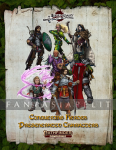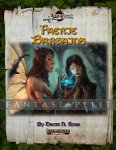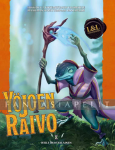Join the Evolution!
The evolution of the Pathfinder Roleplaying Game begins here! The rules in this book pave the way for next year's Pathfinder Second Edition, but we need your help to test and polish them for final release. The new rules make Pathfinder easier to play and learn while still providing the breadth of options that have made it one of the most popular tabletop roleplaying games of the last decade, allowing you to create the character you want to play and craft the stories you want to tell. Your feedback will help to evolve the game even further!
This 432-page rulebook contains everything you need to create and advance your Pathfinder Playtest character from level 1 to 20, as well as hundreds of new and updated spells, magic items, feats, and Game Master rules necessary to run a complete Pathfinder Playtest campaign! Delve the deepest dungeons with a brand-new goblin alchemist hero, or convert your favorite existing characters to the new system! With gorgeous interior art from Pathfinder cover artist Wayne Reynolds and new rules concepts on nearly every page, the Pathfinder Playtest Rulebook is your gateway to the future of Pathfinder. Your next adventure is about to begin!
Welcome to the next evolution of the Pathfinder Roleplaying Game!
Just shy of 10 years ago, on March 18th, 2008, we asked you to take a bold step with us and download the Alpha Playtest PDF for Pathfinder First Edition. Over the past decade, we've learned a lot about the game and the people who play it. We've talked with you on forums, we've gamed with you at conventions, and we've watched you play online and in person at countless venues. We went from updating mechanics to inventing new ones, adding a breadth of options to the game and making the system truly our own. We've made mistakes, and we've had huge triumphs. Now it is time to take all of that knowledge and make the Pathfinder Roleplaying Game even better.
By now, you've probably read all about the upcoming launch of the Playtest version of the game set to release on August 2nd, 2018. In the weeks and months leading up to that release, we are going give you an in-depth look at this game, previewing all 12 of the classes and examining many of the most fundamental changes to the game. Of course, that is a long time to wait to get a complete picture, so I wanted to take this opportunity to give you insight into the game, how it works, and why we made the changes that we made. We will be covering these in much more detail later, but we thought it might be useful to give a general overview right now.
New, but the Same
Our first goal was to make Pathfinder Second Edition feel just like the game you know and love. That means that as a player, you need to be able to make the choices that allow you to build the character you want to play. Similarly, as a Game Master, you need to have the tools and the support to tell the story you want to tell. The rules that make up the game have to fundamentally still fill the same role they did before, even if some of the mechanics behind them are different.
Building a Character
It's worth taking a moment to talk about how characters are built, because we spent a lot of time making this process smoother and more intuitive. You start by selecting your ancestry (which used to be called race), figuring out where you came from and what sorts of basic statistics you have. Next you decide on your background, representing how you were raised and what you did before taking up the life of an adventurer. Finally, you select your class, the profession you have dedicated yourself to as an intrepid explorer. Each one of these choices is very important, modifying your starting ability scores, giving you starting proficiencies and class skills, and opening up entire feat chains tailored to your character.
After making the big choices that define your character, you have a variety of smaller choices to make, including assigning skill proficiencies, picking an ancestry feat, buying gear, and deciding on the options presented by your class. Finally, after deciding on all of your choices, the only thing left to do is figure out all of your bonuses, which are now determined by one unified system of proficiency, based on your character's level.
As you go on grand adventures with your character, you will gain experience and eventually level up. Pathfinder characters have exciting and important choices to make every time they gain a level, from selecting new class feats to adding new spells to their repertoires.
Playing the Game
We've made a number of changes to the way the game is played, to clean up the overall flow of play and to add some interesting choices in every part of the story. First up, we have broken play up into three distinct components. Encounter mode is what happens when you are in a fight, measuring time in seconds, each one of which can mean life or death. Exploration mode is measured in minutes and hours, representing travel and investigation, finding traps, decoding ancient runes, or even mingling at the queen's coronation ball. Of all the modes of play, exploration is the most flexible, allowing for easy storytelling and a quick moving narrative. Finally, the downtime mode happens when your characters are back in town, or relative safety, allowing them to retrain abilities, practice a trade, lead an organization, craft items, or recuperate from wounds. Downtime is measured in days, generally allowing time to flow by in an instant.
Most of the game happens in exploration or encounter mode, with the two types of play flowing easily from one to the other. In fact, exploration mode can have a big impact on how combat begins, determining what you roll for your initiative. In a group of four exploring a dungeon, two characters might have their weapons ready, keeping an eye out for danger. Another might be skulking ahead, keeping to the shadows, while the fourth is looking for magic. If combat begins, the first two begin with their weapons drawn, ready for a fight, and they roll Perception for their initiative. The skulking character rolls Stealth for initiative, giving them a chance to hide before the fight even begins. The final adventurer rolls Perception for initiative, but also gains some insight as to whether or not there is magic in the room.
After initiative is sorted out and it's your turn to act, you get to take three actions on your turn, in any combination. Gone are different types of actions, which can slow down play and add confusion at the table. Instead, most things, like moving, attacking, or drawing a weapon, take just one action, meaning that you can attack more than once in a single turn! Each attack after the first takes a penalty, but you still have a chance to score a hit. In Pathfinder Second Edition, most spells take two actions to cast, but there are some that take only one. Magic missile, for example, can be cast using from one to three actions, giving you an additional missile for each action you spend on casting it!
Between turns, each character also has one reaction they can take to interrupt other actions. The fighter, for example, has the ability to take an attack of opportunity if a foe tries to move past or its defenses are down. Many classes and monsters have different things they can do with their reactions, making each combat a little bit less predictable and a lot more exciting. Cast a fire spell near a red dragon, for example, and you might just find it takes control of your magic, roasting you and your friends instead of the intended target!
Monsters and Treasure
The changes to the game are happening on both sides of the GM screen. Monsters, traps, and magic items have all gotten significant revisions.
First off, monsters are a lot easier to design. We've moved away from strict monster construction formulas based off type and Hit Dice. Instead, we start by deciding on the creature's rough level and role in the game, then select statistics that make it a balanced and appropriate part of the game. Two 7th-level creatures might have different statistics, allowing them to play differently at the table, despite both being appropriate challenges for characters of that level.
This also makes it easier for us to present monsters, giving us more space to include special abilities and actions that really make a monster unique. Take the fearsome tyrannosaurus, for example; if this terrifying dinosaur gets you in its jaws, it can take an action to fling you up to 20 feet through the air, dealing tremendous damage to you in the process!
Hazards are now a more important part of the game, from rangers creating snares to traps that you have to actively fight against if you want to survive. Poisons, curses, and diseases are a far more serious problem to deal with, having varied effects that can cause serious penalties, or even death.
Of all of the systems that Game Masters interact with, magic items are one of the most important, so we spent extra time ensuring that they are interesting and fun. First and foremost, we have taken significant steps to allow characters to carry the items they want, instead of the items that they feel they must have to succeed. Good armor and a powerful weapon are still critical to the game, but you no longer have to carry a host of other smaller trinkets to boost up your saving throws or ability scores. Instead, you find and make the magic items that grant you cool new things to do during play, giving you the edge against all of the monsters intent on making you into their next meal.
We can't wait until you find your first +1 longsword to see what it can do!
What's Next?
There are a lot of things we are excited to show off, so many in fact that we have to pace ourselves. First off, if you want to hear the game in action right now, we've recorded a special podcast with the folks from the Glass Cannon Network, converting the original Pathfinder First Edition Module, Crypt of the Everflame, to the new edition. Head on over to their site and listen to the first part of this adventure now!
Stop by tomorrow for the first blog taking an in-depth look at Pathfinder Second Edition, starting off with the new system for taking actions, then visit us again on Friday for an exploration of the Glass Cannon game, exploring some of its spoilers in detail!
We Need You!
All of us at Paizo want to take a moment to thank you, the fans, players, and game masters that have made this exciting journey a possibility. It's been a wild ride for the past decade, and speaking personally, I could not be more excited for where we are heading. But, as I am sure you've heard a number of times already, we cannot make this game without you, without your feedback and passion for the game. Thank you for coming with us on this adventure, thank you for contributing to our community, and thank you for playing Pathfinder.





























